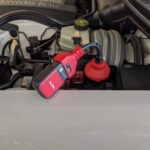The EOBD/OBDII error code P0430 indicates a problem with the efficiency of your vehicle’s catalytic converter. Specifically, it means the catalyst system efficiency is below the acceptable threshold on Bank 2. This article will help you understand what this code means, its potential causes, symptoms, and possible solutions.
What Does P0430 Mean?
The P0430 diagnostic trouble code is a generic powertrain code applicable to OBD-II equipped vehicles. While generic, specific repair steps can vary based on the vehicle’s make and model. Essentially, the oxygen sensor located downstream of the catalytic converter on Bank 2 (the side of the engine that doesn’t contain cylinder #1) detects that the converter isn’t performing as efficiently as expected. This component is crucial for your vehicle’s emissions system, converting harmful pollutants into less harmful substances before they exit the exhaust.
Recognizing Symptoms of a P0430 Code
While a P0430 code might not always result in noticeable driving issues, some potential symptoms include:
- Rough or hard idle, especially when the engine is cold. This can be due to the engine struggling to manage the unburnt fuel passing through the inefficient catalytic converter.
- Check Engine Light illumination. This is the most common indicator of a P0430 code.
- Decreased fuel economy. A malfunctioning catalytic converter can lead to poor fuel efficiency.
- Failed emissions test. Your vehicle might not pass mandatory emissions testing due to the inefficient catalytic converter.
Common Causes of a P0430 Code
Several factors can trigger a P0430 code. Here are the most common causes:
- Faulty Catalytic Converter: The most likely culprit is a damaged or worn-out catalytic converter that’s no longer effectively converting harmful gases. Internal damage, such as a melted honeycomb structure, can significantly reduce efficiency.
- Malfunctioning Oxygen Sensor: A faulty oxygen sensor might be sending incorrect readings to the engine control unit (ECU), triggering the P0430 code even if the catalytic converter is functioning properly. This could be due to a wiring issue, sensor damage, or contamination.
- Exhaust Leaks: Leaks in the exhaust system before the catalytic converter can introduce excess oxygen, disrupting the sensor readings and potentially causing a P0430 code. These leaks can originate from damaged exhaust manifolds, pipes, or gaskets.
Exploring Solutions for a P0430 Code
Diagnosing and resolving a P0430 code typically involves the following steps:
- Inspect for Exhaust Leaks: Thoroughly examine the exhaust system for any visible leaks. Listen for unusual hissing sounds coming from the exhaust.
- Test Oxygen Sensor Voltage: Using a multimeter, measure the voltage of the oxygen sensor on Bank 2. Compare the readings with the manufacturer’s specifications to determine if the sensor is functioning correctly. Testing all oxygen sensors is recommended for a comprehensive diagnosis.
- Check for Engine Misfires: Misfires can damage the catalytic converter over time. Addressing any underlying engine issues is crucial.
- Catalytic Converter Replacement: If the catalytic converter is confirmed to be faulty, replacement is usually necessary.
Conclusion: Addressing the P0430 Error Code
A P0430 code signifies a potential problem with your vehicle’s emissions system. While often manageable, ignoring this code can lead to more severe issues and potentially damage other components. By understanding its causes, symptoms, and solutions, you can effectively address this error code and ensure your vehicle runs smoothly and efficiently while meeting emissions standards. Consult a qualified mechanic for accurate diagnosis and repair.

